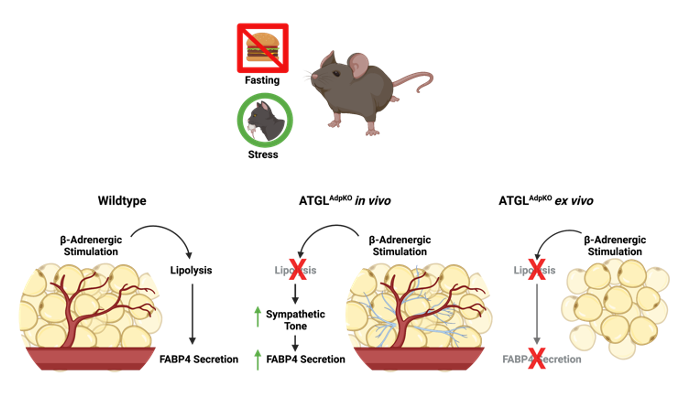In a paper published in the Journal of Lipid Research, Kacey Prentice, PhD, and a group of scientists from the Hotamışlıgil Lab at the Sabri Ülker Center demonstrated that secretion of fatty acid binding protein 4 (FABP4) – an adipokine elevated in metabolic disease – from adipocytes can be induced through sympathetic signaling.
FABP4 is a small lipid binding protein that is secreted from the adipose tissue upon stimulation of lipid breakdown and release. Circulating levels of FABP4 strongly correlate with obesity and metabolic diseases in preclinical models and in humans, and targeting FABP4 improves outcomes. Thus, understanding factors influencing FABP4 release could aid in the development of therapeutics.

In this study, MET researchers investigated the mechanisms regulating the secretion of FABP4 from adipose tissue using a mouse model of ATGL deficiency in adipocytes. Because ATGL is the most proximal catalytic step of the lipolytic process, its deficiency in adipocytes makes it possible to investigate the requirement for the catalytic process in FABP4 secretion from these cells.
Experiments in these mice demonstrated that FABP4 secretion from the adipose tissue is potentiated under conditions of high stress, correlating with corticosterone/cortisol levels. Unexpectedly, this stress signal could overcome the requirement for lipid breakdown in mediating FABP4 release. Reducing sympathetic signals acutely using pharmacological blockers, or chronically by housing animals at thermoneutrality, reduced FABP4 secretion.
Together, these findings indicate that the sympathetic system plays a key role in FABP4 release. Given the strong link between hormonal FABP4 and a multitude of metabolic diseases in both mice and humans, the results have broad relevance and implications.
Congratulations to Kacey, Alexandra, Paulina, Karen, Meric, Jillian, Grace, and of course Gökhan for your incredible work!
Click to Access Publication


